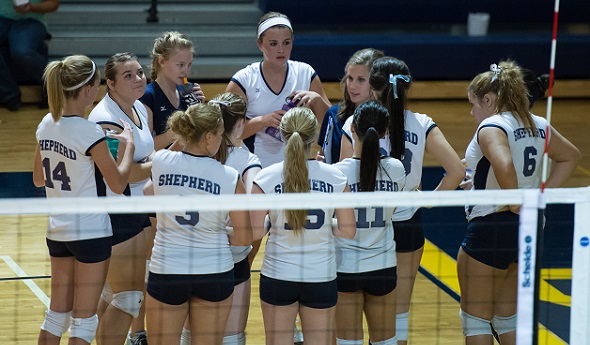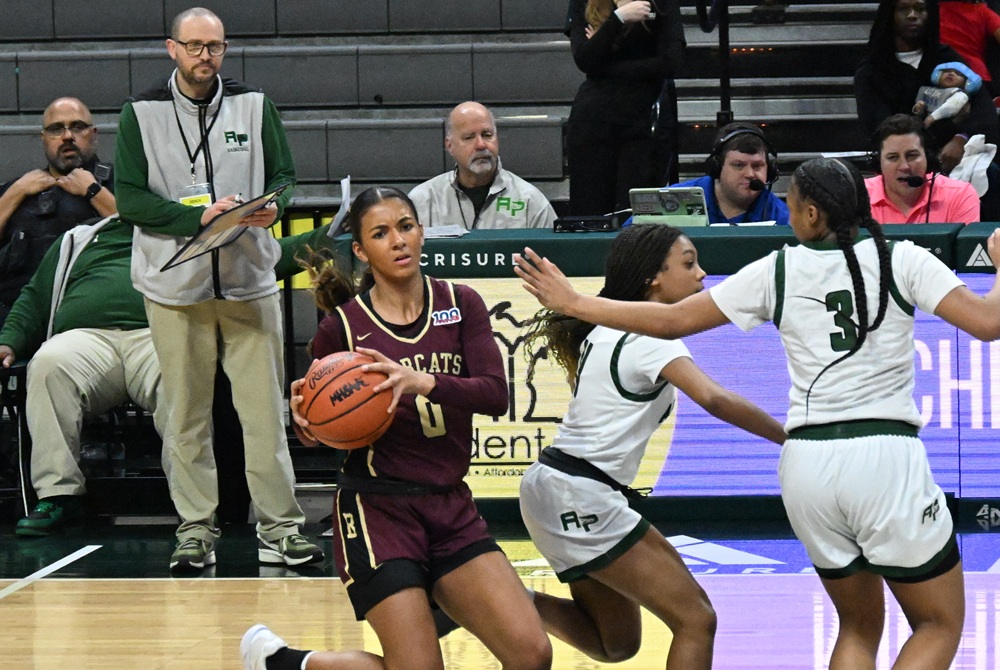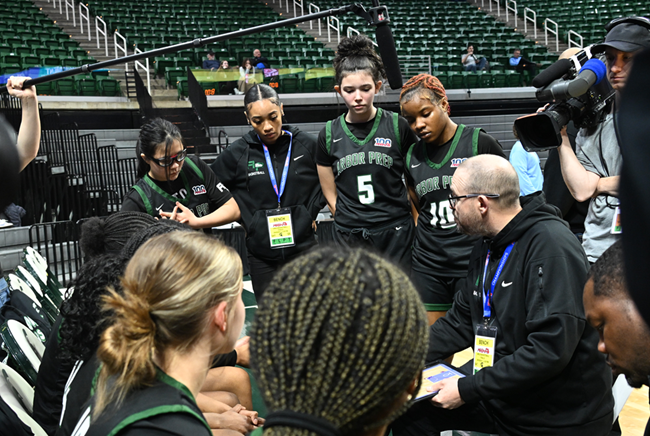
Using Heads in the Heat of Competition
December 20, 2013
By Rob Kaminski
MHSAA benchmarks editor
With so much recent attention to the risks and recognition of concussions in collision sports, athletic leaders have put their heads together to address far more common – but often overlooked – threats to the health of our student-athletes: heat and sudden cardiac arrest.
The No. 1 killer of young athletes is sudden cardiac arrest, while heat stroke victims can surpass that during the year’s hottest months. While the moment of impact leading to a concussion is totally unpredictable, athletic trainers, coaches and administrators have the ability to diminish the occurrences of cardiac arrest and heatstroke. Typically, there is a pre-existing condition, or family history suggesting probabilities for sudden cardiac arrest, which can be treated when detected. And, the perils associated with hot weather – heat stroke, prostration – are almost always completely preventable.
The MHSAA has addressed both issues recently. With assistance from numerous medical governing bodies, the annual pre-participation physical form was revamped and expanded prior to the 2011-12 school year to include comprehensive information regarding participants’ medical history.
In May, the Representative Council adopted a Model Policy for Managing Heat & Humidity (see below), a plan many schools have since adopted at the local level. The plan directs schools to monitor the heat index at an activity site once the air temperature reaches 80 degrees and provides recommendations when the heat index reaches certain levels, including ceasing activities when it rises above 104 degrees.
The topic of heat-related illnesses receives a lot of attention at the start of fall when deaths at the professional, collegiate and interscholastic levels of sport occur, especially since they are preventable in most cases with the proper precautions. In football, data from the National Federation of State High School Associations shows 41 high school players died from heat stroke between 1995 and 2012.
“We know now more than we ever have about when the risk is high and who is most at risk, and we’re now able to communicate that information better than ever before to administrators, coaches, athletes and parents," said Jack Roberts, executive director of the MHSAA. “Heat stroke is almost always preventable, and we encourage everyone to avail themselves of the information on our website.
“Schools need to be vigilant about providing water during practices, making sure that students are partaking of water and educating their teams about the need for good hydration practices.”
All of which is not to say concussions aren’t a serious matter; they are. In fact, leaders in sport safety can take advantage of the concussion spotlight to illuminate these additional health threats.
A recent New York Times story (May 2013) by Bill Pennington featured a February 2013 gathering in Washington organized by the National Athletic Trainers Association. In the article, Dr. Douglas J. Casa, professor of kinesiology at the University of Connecticut and Chief Operating Officer of the Korey Stringer Institute (founded in the late NFL offensive lineman’s name to promote prevention of sudden death in sport), suggests just that.
“All the talk about head injuries can be a gateway for telling people about the other things they need to know about, like cardiac events and heat illness,” said Casa in the article. “It doesn’t really matter how we get through to people as long as we continue to make sports safer.”
Education and prevention methods need to find a permanent place in school programs if those programs are to thrive and avoid becoming targets at which special interest groups can aim budgetary arrows.
Dr. Jonathan Drezner, the president of the American Medical Society for Sports Medicine, said in the New York Times piece that sudden cardiac arrest is “so incredibly tragic and stunning that people aren’t comfortable putting it into the everyday conversation. I do wish, to some extent, it was something people talked more about because we are getting to a place where we could prevent many of these deaths.”
When it comes to heat-related deaths or illnesses, the prevention efforts can be even more successful by educating the masses. And, these efforts can be done at minimal cost to schools.
“That’s the thing about curtailing exertional heat illness: it’s 100 percent preventable, and unlike other health threats to athletes, the solutions can be very low-tech and inexpensive,” said Dr. Michael F. Bergeron, the director of the National Institute for Athletic Health & Performance at the University of South Dakota’s Sanford Medical Center, in the New York Times story.
To assist with cost and data maintenance, the MHSAA has teamed with Sports Health to provide schools with psychrometers (heat measurement instruments) at a discounted rate, and has built online tools to track heat and humidity conditions.
Managing heat and humidity policy
- Thirty minutes prior to the start of an activity, and again 60 minutes after the start of that activity, take temperature and humidity readings at the site of the activity. Using a digital sling psychrometer is recommended. Record the readings in writing and maintain the information in files of school administration. Each school is to designate whose duties these are: generally the athletic director, head coach or certified athletic trainer.
- Factor the temperature and humidity into a Heat Index Calculator and Chart to determine the Heat Index. If a digital sling psychrometer is being used, the calculation is automatic.
If the Heat Index is below 95 degrees:
All Sports
- Provide ample amounts of water. This means that water should always be available and athletes should be able to take in as much water as they desire.
- Optional water breaks every 30 minutes for 10 minutes in duration.
- Ice-down towels for cooling.
- Watch/monitor athletes carefully for necessary action.
If the Heat Index is 95 degrees to 99 degrees:
All Sports
- Provide ample amounts of water. This means that water should always be available and athletes should be able to take in as much water as they desire.
- Optional water breaks every 30 minutes for 10 minutes in duration.
- Ice-down towels for cooling.
- Watch/monitor athletes carefully for necessary action.
Contact sports and activities with additional equipment:
- Helmets and other possible equipment removed while not involved in contact.
- Reduce time of outside activity. Consider postponing practice to later in the day.
- Recheck temperature and humidity every 30 minutes to monitor for increased Heat Index.
If the Heat Index is above 99 degrees to 104 degrees:
All Sports
- Provide ample amounts of water. This means that water should always be available and athletes should be able to take in as much water as they desire.
- Mandatory water breaks every 30 minutes for 10 minutes in duration.
- Ice-down towels for cooling.
- Watch/monitor athletes carefully for necessary action.
- Alter uniform by removing items if possible.
- Allow for changes to dry T-shirts and shorts.
- Reduce time of outside activity as well as indoor activity if air conditioning is unavailable.
- Postpone practice to later in the day.
Contact sports and activities with additional equipment
- Helmets and other possible equipment removed if not involved in contact or necessary for safety.
- If necessary for safety, suspend activity.
Recheck temperature and humidity every 30 minutes to monitor for increased Heat Index.
If the Heat Index is above 104 degrees:
All sports
- Stop all outside activity in practice and/or play, and stop all inside activity if air conditioning is unavailable.
Note: When the temperature is below 80 degrees there is no combination of heat and humidity that will result in need to curtail activity.
PHOTO: The Shepherd volleyball team includes hydration during a timeout in a match this fall.

Stine Bringing Championship Formula to Lumen Christi After Marvelous Arbor Prep Run
By
Doug Donnelly
Special for MHSAA.com
November 25, 2025
One of the first things Scott Stine noticed when he started his new gig as girls basketball head coach at Jackson Lumen Christi wasn’t the historic dome where the Titans play or the trophy cases just inside the entrance to the school.
 It was the fellow coaches on staff at Lumen Christi.
It was the fellow coaches on staff at Lumen Christi.
“Everybody knows who (football coach) Herb (Brogan) is, but he is not only one of the greatest coaches ever, but probably the nicest guy you will ever meet,” Stine said. “He’s so humble. I very much enjoy getting to know him better.”
There’s more.
“Here, you are just surrounded by so many great coaches. I think the cross country coach (Mike Woolsey) has 12 state championships. The golf coach (Dave Swarthout) has 18 or something like that. We have coaches who are complete Hall of Famers who are around here every day.
“Everybody has been welcoming. It’s gone as good as I could hope for.”
Stine was a highly-successful girls basketball coach at Ypsilanti Arbor Prep for the past eight seasons, winning eight District, five Regional and three Finals titles during his tenure. Last season was perhaps the biggest surprise of all when he led an Arbor Prep team that was 10-12 during the regular season to seven straight wins in the MHSAA Tournament and the Division 3 championship.
“For my last year there, it couldn’t have worked out any better,” Stine said. “I think even I didn’t expect that one.”
Stine, however, turned some heads across the state when he decided in May to leave Arbor Prep and a program he has been around since the launch of the school 14 years ago to coach girls basketball at Lumen Christi. He left the job of athletic director and assistant principal as well and is now teaching world history and economics in Jackson.
He said those close to him probably weren’t surprised by the move – although he loved coaching at Arbor Prep.
“It will always have a huge, special place in my heart,” he said. “Leaving the basketball program was one of the toughest decisions I’ve had to make in my life.”
He takes over the Lumen Christi team that was 19-7 last winter with one of the most celebrated freshmen in the state in Kenna Hunt. Athletic director Jesse Brown coached the team but helped lure Stine and his 157-47 record to Jackson. The Titans actually ended their season with a 31-28 Quarterfinal loss to Stine’s Gators.
 “The transition here has been everything I hoped it would be,” Stine said. “You have a community that definitely care about excellence. Faith comes first, then academics. Sports are a big priority. At this point, there’s no reason not to be successful here.”
“The transition here has been everything I hoped it would be,” Stine said. “You have a community that definitely care about excellence. Faith comes first, then academics. Sports are a big priority. At this point, there’s no reason not to be successful here.”
He noted the positive environment at Lumen Christi.
“There is just an excitement at the school in general,” he said. “I have a lot of football kids in class. They’ve been excited since day one to see what can happen with the girls program. It’s a great community.”
Stine graduated from Muskegon Oakridge in 1996 and Grand Valley State University in 2002. He was on the Arbor Prep staff under Rod Wells when the Gators won their first Finals title in 2016.
At Lumen Christi, he will build around four returning starters, including Hunt, Lucy Wrozek, Lily Ganton and Ruby Boyce. He also has a talented group of freshmen and sophomores and a host of multi-sport athletes.
“Our fall workouts were pretty much all freshmen and sophomores,” he said. “The seniors will help us. They have things to offer. I’m really excited about our freshmen.”
Freshman Tristin Johnson will be on varsity from day one. She’s a point guard who plays on the Lumen Christi football team.
“She’s tough,” Stine said.
One of his first tasks at Lumen Christi was to upgrade the schedule.
“Our schedule has to be one top five toughest in the state,” Stine said. “In the Catholic League we play (Toledo) Notre Dame twice, (Toledo) Central Catholic is going to be pretty good. We play Ann Arbor (Father Gabriel) Richard twice. Those are six games that are pretty tough.
“We play Michigan Center in our opener and they are solid. We are playing Salem. Rod (Wells) and I get to go against each other. That will be tough because he’s one of my best friends.”
Also on the schedule is Detroit Country Day, Anthony Wayne from Ohio – which won 25 games last year – and Rockford.
“Maybe it didn’t need to be quite as tough as it ended up,” Stine said. “I had to tell our parents, ‘Listen, we want to win every game. There’s no one who wants to win every game more than I do. But we’re going to lose some games, probably. That’s just the way it is. The key is, once we get to March, we’ll be ready. We’ll be challenged. We’ll have seen every type of team, every style.
“That recipe proved to work at Arbor Prep. We’re sticking to that.”
 Doug Donnelly has served as a news and sports reporter at the Adrian Daily Telegram and the Monroe News for 30 years, including 10 years as city editor in Monroe. He's written a book on high school basketball in Monroe County and compiles record books for various schools in southeast Michigan. He is now publisher and editor of The Blissfield Advance, a weekly newspaper. E-mail him at [email protected] with story ideas for Jackson, Washtenaw, Hillsdale, Lenawee and Monroe counties.
Doug Donnelly has served as a news and sports reporter at the Adrian Daily Telegram and the Monroe News for 30 years, including 10 years as city editor in Monroe. He's written a book on high school basketball in Monroe County and compiles record books for various schools in southeast Michigan. He is now publisher and editor of The Blissfield Advance, a weekly newspaper. E-mail him at [email protected] with story ideas for Jackson, Washtenaw, Hillsdale, Lenawee and Monroe counties.
PHOTOS (Top) Then-Arbor Prep coach Scott Stine pulls out his clipboard while monitoring his team’s play during last season’s Division 3 Semifinal against Niles Brandywine. (Middle) Stine talks things over with his Arbor Prep players during a break in the championship victory.

